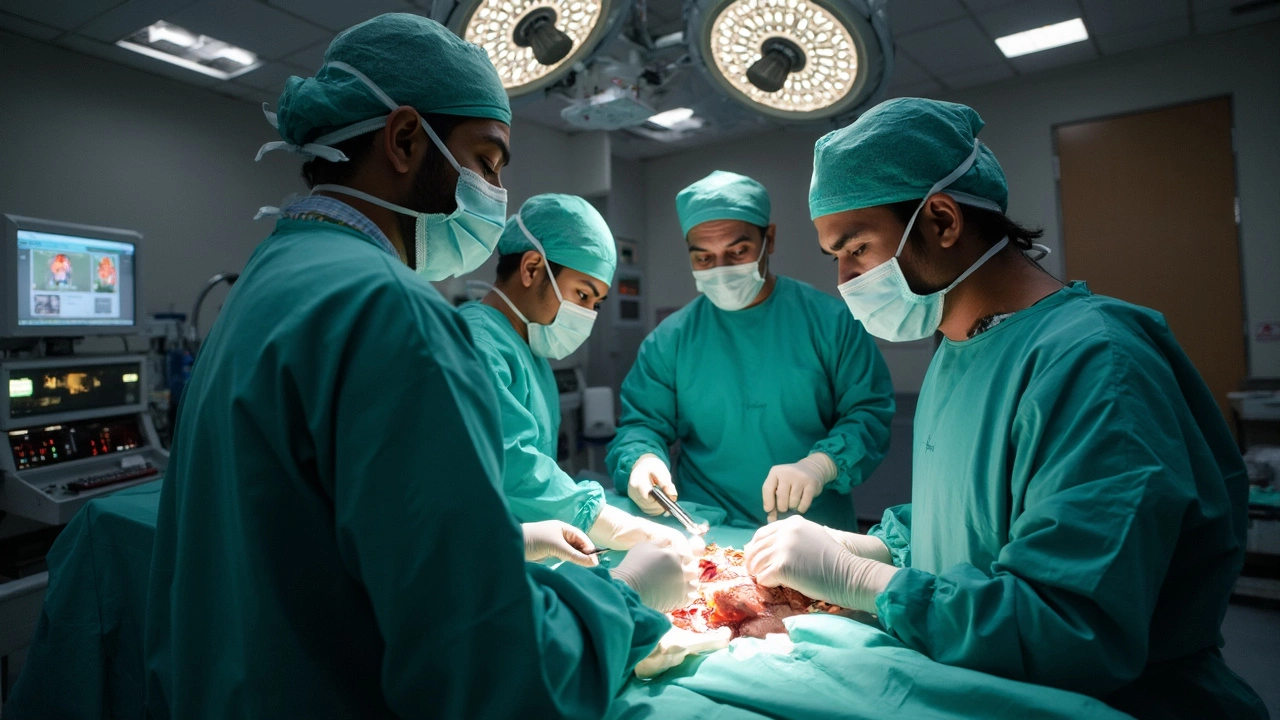Ask anyone who spends their days in the OR, and they’ll tell you—some heart surgeries crank up the pressure like no other, even for surgeons with nerves of steel. Not all heart procedures are the same. Some are like changing a tire; others feel more like rebuilding a car engine while it’s still running.
The word “hardest” can mean different things here. Are we talking about the riskiest for the patient? The trickiest for the surgeon’s hands? Or the procedure with the most things that can swing out of control in minutes? Either way, the name that shows up again and again is the heart transplant. But there’s serious competition from complex repairs in babies’ hearts and dangerous aorta surgeries too.
Tough surgeries make patients and their families nervy, and for good reason. If you or someone you care about needs one, it helps to know what sets these operations apart. Getting clear on the options, the risks, and what’s actually happening in that high-tech OR can make the difference between fear and confidence.
- Defining ‘Hardest’ in Heart Surgery
- Heart Transplants: The Giant Challenge
- Pediatric Heart Surgery: Tiny Hearts, Big Risks
- Aortic Root and Arch Repairs: Danger Zones
- How Surgeons Prepare for the Toughest Cases
- Recovery and Life After High-Risk Heart Surgery
Defining ‘Hardest’ in Heart Surgery
What actually makes a heart surgery the hardest? Surgeons usually judge by a mix of things: technical complexity, how risky it is for the patient, and how much can go wrong in the middle of the operation. Sometimes, it’s not just the cutting or stitching—it’s what happens if the patient’s heart or other organs can’t handle the stress.
Here’s where it gets complicated. Some heart surgeries are tough because the patient is very sick to start with, like in heart transplants. Other times, it’s the actual anatomy that’s complicated—tiny babies with birth defects, or adults with weirdly shaped blood vessels. In still other cases, the danger is all about speed: where every second counts, and a mistake can mean bad news fast.
Take a look at how heart surgeries stack up on different ‘hardness’ factors:
| Factor | Why It Matters | Examples |
|---|---|---|
| Technical Complexity | Hard maneuvers, tiny blood vessels, lots of sewing | Pediatric valve repairs, aortic root reconstructions |
| Patient Condition | Weakened heart, failure of other organs | Heart transplantation, emergency surgeries |
| Time Pressure | Fast decision-making needed, minimal room for error | Ruptured aortic aneurysm repair |
| Innovation Needed | No “standard” way, surgeon must adapt | Unusual congenital heart defects |
Dr. John Elefteriades, a legend in heart surgery, once put it this way:
“The hardest heart surgeries are those when the anatomy isn’t in the book. Every stitch counts double, and you just can’t lose focus, even for a few seconds.”
So, next time you hear someone talk about ‘the hardest heart surgery,’ remember—there’s more than one way to measure tough. For some cases, it’s all about the wild anatomy. For others, it’s the patient’s fragile situation, and for some, it’s beating the clock.
Heart Transplants: The Giant Challenge
When you ask cardiac surgeons about the toughest procedure, most will point straight at heart transplant. It’s not just about swapping out a broken heart for a new one—this operation is a full-on team effort where timing, skill, and luck all have to line up just right.
First off, not many people get to the operating table. In the US, only about 3,500 heart transplants happen each year. That’s mostly because donor hearts are rare and matching is tricky. The whole thing runs on a tight schedule: once a donor heart is ready, the team has about 4 to 6 hours to get it into the recipient. Any longer and the heart can be damaged beyond repair.
The risks are stacked. Rejection, infections, and complications from powerful immune-suppressing drugs are just part of the story. During surgery itself, the surgeon has to cut out the diseased heart, keep the rest of the body alive on a heart-lung machine, and carefully sew in the new heart, making sure the plumbing matches up and nothing leaks.
"A heart transplant is like defusing a bomb with a ticking timer. Everything must go perfectly the first time," says Dr. Sharon Hunt, a pioneer in transplant cardiology at Stanford.
Here’s how the process breaks down:
- The recipient is prepped and placed on a heart-lung (bypass) machine.
- The surgeon removes the damaged heart and quickly checks the donor heart for issues.
- The healthy donor heart is stitched in, connecting four main blood vessels perfectly.
- The new heart is shocked to start beating and gradually takes over pumping blood.
Now for the numbers. Take a look at this snapshot from the International Society for Heart and Lung Transplantation (ISHLT):
| Heart Transplant Stat | Data (2024) |
|---|---|
| Median recipient age | 53 years |
| One-year survival rate | 89% |
| Five-year survival rate | 75% |
| Average wait time (US) | 6-12 months |
Recovery? It’s a marathon, not a sprint. Patients will need constant checkups, lots of meds to keep their immune system from rejecting the new heart, and real changes to daily habits. For most though, getting a heart transplant means a shot at life they wouldn’t otherwise have.
Pediatric Heart Surgery: Tiny Hearts, Big Risks
Operating on babies and little kids is on a whole different level compared to adults. Their hearts are tiny—sometimes barely bigger than a walnut—which makes every move in surgery ten times harder. Even the tools have to be scaled down and super precise. Most pediatric cases aren’t your usual clogged arteries or damaged valves. It's about fixing birth defects, some so rare they don’t have simple names—like Tetralogy of Fallot, hypoplastic left heart, or transposition of the great arteries.
So, why is pediatric heart surgery such a big deal? First, tiny patients don’t have much room for error. A little too much pressure from the surgical tools and you could cause bleeding or other damage instantly. Second, little bodies can’t take blood loss or low oxygen for long, so time’s always ticking. Third, the heart defects often require patching things up creatively—sometimes even rerouting where the blood flows entirely.
Here’s a look at the challenges that make pediatric heart surgeries some of the hardest heart surgery procedures out there:
- Size and fragility: Vessels and chambers can be one millimeter wide, so there’s no room for shaky hands.
- Complex anatomy: Some kids have hearts that are so different from the norm that surgeons basically have to customize the fix on the spot.
- Unpredictable recovery: Even after a textbook-perfect operation, kids’ hearts sometimes don’t bounce back right away, and every minute counts in the ICU.
If you look at the stats, survival rates for common pediatric heart surgeries have improved a lot over the decades. Here’s a quick comparison for some major birth defect repairs:
| Procedure | Average Success Rate (US, 2024) |
|---|---|
| Tetralogy of Fallot Repair | 96% |
| Hypoplastic Left Heart (first-stage repair) | ~80% |
| Arterial Switch Operation | 97% |
Those numbers look good on paper, but each percentage point reflects years of research, new tools, and surgeons training like elite athletes. If you’re a parent facing this world for the first time, get every question answered and make sure your surgeon has serious experience. Don’t be shy about asking how often they do these procedures or how their results stack up against national averages. When it comes to kids, you want the best hands in the room.

Aortic Root and Arch Repairs: Danger Zones
If heart transplants are dramatic, aortic root and arch repairs are nerve-wracking in a whole different way. The aorta is the main highway for blood from the heart to the rest of your body. When there’s a problem at the root or arch—like an aneurysm or a tear—there’s no time to mess around. It’s a race against the clock because a busted aorta can mean bleeding out within minutes.
These surgeries make even the most seasoned heart surgeons tighten their grip. Why? The operation happens deep in the chest and right where the heart meets its main outflow “pipe.” One slip and you’re in trouble. Plus, the aortic arch curves over the top of the heart and branches out to supply the brain and upper body, so every millimeter matters for avoiding a stroke or brain damage.
Here’s why these repairs are so intense:
- Surgeons often have to stop the patient’s heart and sometimes cool the body to protect the brain, a move called “deep hypothermic circulatory arrest.”
- There’s a high risk of bleeding, since the aorta is under strong pressure.
- Timing is critical—some repairs are emergencies, especially when the aorta is tearing apart (aortic dissection).
- If the arch is involved, surgeons must make sure blood flow to the brain doesn’t get interrupted, even for a moment.
Check out how risky this gets compared to other heart surgeries, based on big studies:
| Heart Surgery Type | General Mortality Rate (%) | Average Surgery Duration (Hours) |
|---|---|---|
| Routine Bypass (CABG) | 1–2% | 3–5 |
| Aortic Root/Arch Repair | 8–15% | 7–10 |
| Heart transplant | 5–10% | 4–8 |
If you want to stay away from this type of heart drama, controlling high blood pressure is key. Smoking also puts your aorta at major risk. If you have a family history of aortic disease or conditions like Marfan syndrome, regular checkups matter way more than people realize.
Not every hospital handles these procedures. Surgeons need extra training, and it’s usually a team of experts working in a specialized center. When people survive aortic root or arch repair, it’s not just luck—it took careful teamwork, crazy attention to detail, and nerves of steel.
How Surgeons Prepare for the Toughest Cases
When it comes to handling the hardest heart surgery, surgeons don’t just walk in and hope for the best. Preparation is everything, especially when someone’s life is literally in their hands. Here’s what top cardiac teams actually do to get ready.
First up, it’s all about planning. Surgeons study the patient’s scans, history, and previous surgeries backward and forward. In many big hospitals, there’s something called a “heart team” approach—meaning several experts (surgeons, cardiologists, anesthesiologists, and more) work together to plan every move. If they’re doing a transplant or a tough repair, they hold simulation sessions, kind of like flight practice for pilots but in the hospital’s training room. High-fidelity mannequins or even virtual reality get used for real-life scenarios.
- They check, double-check, and triple-check all the specialized tools and devices needed. One missing piece can cause big problems during surgery.
- They study 3D models of the person’s heart if it helps spot hidden trouble areas.
- If it’s a transplant, the team literally races the clock. Timing for donor organ arrival and prepping the patient is mapped out down to the minute.
Surgeons also make sure everyone on the room knows exactly what to do if things go sideways. This includes emergency plans if the heart doesn’t restart or unexpected bleeding happens.
If you’re wondering how common all this careful prep is, check this table. These are steps taken by most leading heart centers before high-risk surgeries:
| Preparation Step | Percentage of Centers Using |
|---|---|
| Team planning meetings | 98% |
| 3D imaging/modeling | 78% |
| Simulation training | 65% |
| Detailed equipment checklists | 89% |
But it’s not just about tech and teamwork. The top surgeons stay sharp by doing regular practice, reading the latest research, and sometimes even sharing stories with their peers about close calls. They want to know about new tricks for cutting bleeding or stitching up delicate areas, especially for kids or complicated donor hearts.
If you’re facing surgery, you can ask your doctor about how the team prepares. Some hospitals even let you meet parts of the team ahead of time, which can help calm your nerves and build trust. Knowing what goes on behind the scenes really helps you see just how much thought goes into making these surgeries as safe as possible.
Recovery and Life After High-Risk Heart Surgery
So, you or a loved one made it through the hardest heart surgery—what happens now? Here’s the real deal: the work isn’t over when you leave the operating room. Recovery can test your patience, but it’s totally possible if you know what’s coming and get the right support.
Let’s talk timelines. Most folks stay in the ICU for a few days, then in the hospital for a week or more. If you get a heart transplant, you’re usually looking at a month-long hospital stay. The first few weeks at home are crucial for spotting infection and making sure the new heart or repaired vessel is doing its job. Doctors and nurses check you often during this time.
The rules for recovery are no joke. Check out this list of what every high-risk heart surgery patient gets told before heading home:
- Watch for symptoms like fever, new pain, or shortness of breath—don’t ignore weird changes
- Follow up with your cardiologist, sometimes every week at first
- Stick to your meds, especially those that stop your body from attacking a new heart
- Eat low-salt, low-fat foods, and drink as advised (sometimes fluids are limited)
- Start light activity as guided—walking is better than bed rest, but avoid heavy lifting
One phrase you’ll hear a lot is, “Everyone heals at their own pace.” For some, walking up stairs is easy in a month. For others, it takes several months. Kids usually bounce back faster than adults, but it still takes time.
Here’s a quick snapshot of what recovery stats actually look like. These are real numbers from major US hospitals:
| Type of Surgery | Avg. Hospital Stay (days) | Risk of Major Complications (%) |
|---|---|---|
| Heart Transplant | 21–30 | 35 |
| Complex Aortic Surgery | 10–14 | 25 |
| Pediatric Heart Surgery | 7–21 | 30 |
Mental health is a big piece of the puzzle. It’s pretty common to feel down, anxious, or even guilty about recovery, especially if you need help from family. Talking to a therapist helps. Some hospitals run peer support groups, so you can swap stories with people in the same boat.
As Dr. Maria Torres, transplant cardiologist at Cleveland Clinic, puts it:
“Surviving the toughest surgeries is only half the battle—the real progress happens at home, one day at a time.”That daily routine matters way more than one magical hospital day. Building new habits, getting the right check-ups, and leaning on others can make a world of difference.
Bottom line? Life after high-risk surgery isn’t exactly back to square one, but with the right moves and a little patience, most people get back to living—a little slower at first, but with a pretty full tank in the long run.

 Top 5 Cancer Treatments Explained: Latest Advances and What to Expect
Top 5 Cancer Treatments Explained: Latest Advances and What to Expect
 What Is the Most Expensive Surgery? Costs, Reasons, and What It Includes
What Is the Most Expensive Surgery? Costs, Reasons, and What It Includes
 Unveiling the Secrets of Vitamin C for Radiant Skin
Unveiling the Secrets of Vitamin C for Radiant Skin
 Biggest Health Concerns Facing Medical Tourists in Costa Rica
Biggest Health Concerns Facing Medical Tourists in Costa Rica
 How Much Weight to Lose for Reversing Type 2 Diabetes?
How Much Weight to Lose for Reversing Type 2 Diabetes?